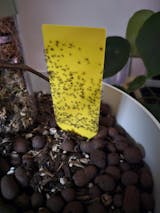Easy Trap Stickies 5 pack - Mini yellow sticky traps for Fungus Gnats
- Regular Price
- $7.40
- Sale Price
- $7.40
- Regular Price
- Unit Price
- Translation missing: en.general.accessibility.unit_price_separator
It's not me, it's you. I have a love hate relationship with Fungus Gnats. They love my plants, I hate them.
When I first started collecting plants I was quickly over-run by Fungus Gnats. And because they love carbon dioxide, the only thing more appealing to them than the moist soil of my plants, was the CO2 in my breath, so you always know when you have Fungus Gnats. Even one or two and they'll quite literally be all up in your face. Plus I couldn't leave a cup of tea uncovered without finding little unwanted floaters, and I really love my tea. They had to go.
The secret is to break the cycle
If you get on top of them while the infestation is small, the good news is they are more annoying than harmful and should leave your plant's roots alone. I tried almost every remedy to kill them. Most helped reduce but not eradicate. What DID finally work for me, was the combo of Mozzie Bits and Sticky Traps. Mozzie Bits kill the larvae. Sticky Traps kill the breeding adults. Used together you can break the cycle, which is the key for saying bye bye to Fungus Gnats once and for all.
Why do yellow sticky traps get rid of Fungus Gnats?
Nothing scientific here. Fungus Gnats land on the surface of your plant's soil to lay eggs. They are attracted to the colour yellow. Lay a sticky trap on the surface of your soil, and voila, you've trapped yourself a Fungus Gnat. Since one pesky gnat can lay a good 30 to 200 eggs, every gnat you trap hugely reduces your Fungus Gnat population.
How should you use yellow sticky traps to kill Fungus Gnats?
One pack of sticky traps comes with 5 double-sided sticky traps included. The pack will tell you to peel off the paper from both sides, then stick the pointy end in the soil. Nuh uh. Great for other insects (as these traps also work for thrips, aphids, whitefly and more), but for Fungus Gnats, I've had much better results using them this way...
My method for using sticky traps for indoor plants
Remove the paper on one side of the trap only, exposing the sticky surface. Lay the trap down flat, sticky side up, on the soil surface. And yes, you can cut them in half or smaller for smaller pots (each trap measures 16cm long x 6cm wide) but if you want to do that, cut before removing the protective paper. It's best to cover at least one quarter of the soil surface, ideally one half, with the trap.
Lay the trap flat on the soil after watering with Mozzie Bits. I find the trap stays sticky a good week or two (the dustier the air is in your house, the faster they lose their stickiness). Every couple of weeks, flip the trap over, peel off the paper on the other side to expose a fresh sticky layer, and you get double the use compared to how they recommend using them. Once both sides are used up, get a new trap (there are 5 double-sided traps in each pack). Used the way I do, you'll get up to 4 weeks Fungus Gnat trapping from each trap, instead of 2 weeks, and catch many more gnats than using them upright.
How long do you need to keep treating to get rid of Fungus Gnats?
In warmer months, treat for at least 4 weeks, using a combo of sticky traps and drenches with mozzie tea using Mozzie Bits. I treated for 2 months but the Fungus Gnat lifecycle when it's warm averages 17 days, whereas in cooler temperatures it can be 4 or 5 weeks, which is why at least 4 weeks is recommended (or until they're gone).
Will the Fungus Gnats come back after treatment?
Yes they can. The combo of Mozzie Bits and Sticky Traps deals with the larvae and the adults. It doesn't prevent them coming back, but YOU can make sure that doesn't happen. The main source of Fungus Gnats is new plants. They won't usually arrive with swarms of gnats buzzing around, as the adults normally buzz off when the plant's picked up and moved, but once your new arrival has settled in, new adults hatch from the eggs and larvae hidden in the soil, and they're back!
Always isolate a new plant for at least 2 weeks and if you do find any flyers, you can much more easily treat just that one plant.
Soil stored outside is also Fungus Gnat heaven. It's not the soil itself as such, but the combo of being moist and stored outside that does it. Just storing soil inside doesn't mean Fungus Gnats will find it. Moist soil left outside is an irresistible combo. If you're unsure how your soil's been stored, before potting up, give the soil you're about to use a good drench with mozzie tea (made from Mozzie Bits).
The other place these annoying insects commonly set up home in our indoor plants, is when you put your plants outside - especially if you've just watered! You're basically putting a 'Vacancy' sign up and your plant is Fungus Gnat hotel central. Bring your plants back inside, and you've bought some uninvited guests along with it.





